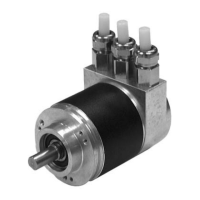Absolute rotary encoder P**58
Manufacturer specific encoder classes
Subject to reasonable modifications due to technical advances. Copyright Pepperl+Fuchs, Printed in Germany
Pepperl+Fuchs Group • Tel.: Germany +49 621 776-0 • USA +1 330 4253555 • Singapore +65 67799091 • Internet http://www.pepperl-fuchs.com
Date of issue 01/15/04
24
5.3 Commissioning mode
If the rotary encoder is switched into commissioning mode using parameter
assignment, gear factors can be determined directly on the system using a process
called "TEACH-IN".
Commissioning mode is indicated by the rotary encoder by the flashing green LED in
the connection hood and by Bit 26 in the input double word (set to 0).
In commissioning mode, parameters set in projecting mode (direction of rotation and
scaling) are ignored. Instead of them, values stored internally in EEPROM are used.
If the direction of rotation and gear factor are changed in commissioning mode, the
new values are stored in EEPROM and the device will then use these new values.
The main procedure in commissioning mode is as follows:
• Install the device into the system.
• Turn on commissioning mode with parameter assignment (see section 5.1.4).
• If necessary, adjust the direction of rotation.
• Move the system to its initial position.
• Transfer the Start command for TEACH-IN to the rotary encoder.
• Move the system to its end position.
• Use the TEACH-IN stop command to transfer the desired number of steps to the
rotary encoder.
• The preset value is set.
• Transfer the values determined in TEACH-IN to projecting (parameters).
• Commissioning mode is turned off in parameter assignment.
5.3.1 Setting the direction of rotation
The direction of rotation in which the output code rises can be changed online in
commissioning mode. The current direction of rotation is displayed with Bit 28 in the
input double word (0: rising/1: falling, clockwise). The direction of rotation can be
changed with Bit 28 in the output double word.
The direction of rotation that is set is saved zero-voltage-safe in EEPROM.
Status bits Data bits
Bit
31 30 29 28 27 26 25 24 23 22 21 20 19 18 17 16 15 14 13 12 11 10 987654321 0
Master →
Encoder
000 1 000
changeover of direction of rotation via Bit 28
Encoder
→ Master
0000/1 001
rotary encoder acknowledged in Bit 0 and Bit 28 with new
direction of rotation
0/1
Master →
Encoder
000 0 000
changeover is ended by resetting Bit 28
Encoder
→ Master
0000/1 X01
output of actual process value with modified direction of
rotation

